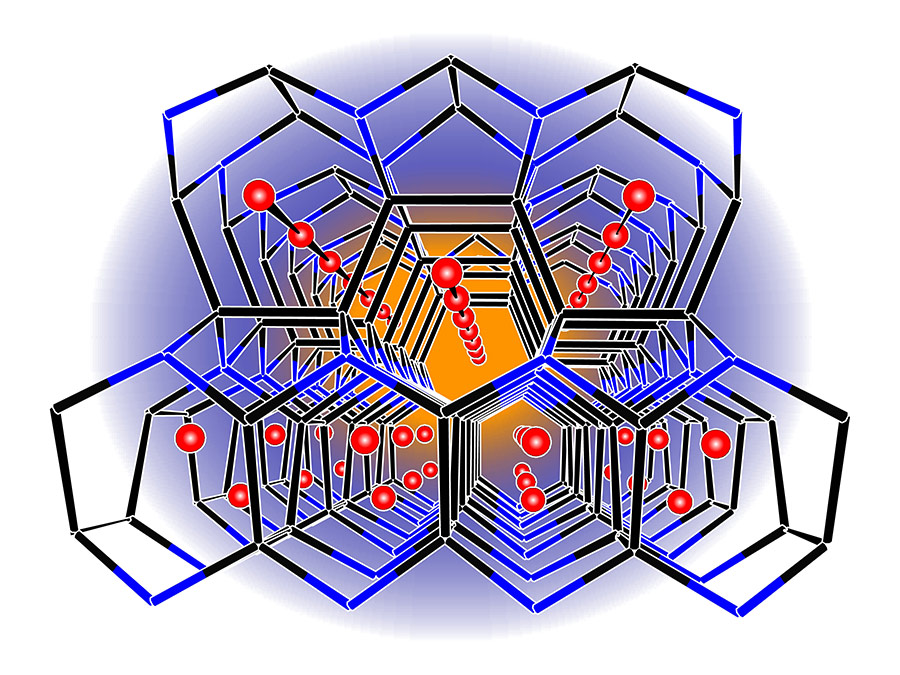New framework from boron and silicon could smooth the way to higher capacities:
Promising material for lithium-ion batteries

Loading a lithium-ion battery produces lithium atoms that are taken up by the graphite layers of the negative electrode. However, the capacity of graphite is limited to one lithium atom per six carbon atoms. Silicon could take up to ten times more lithium. But unfortunately, it strongly expands during this process – which leads to unsolved problems in battery applications.
Looking for an alternative to pure silicon, scientists at the Technische Universität München have now synthesized a novel framework structure consisting of boron and silicon, which could serve as electrode material. Similar to the carbon atoms in diamond, the boron and silicon atoms in the novel lithium borosilicide (LiBSi2) are interconnected tetrahedrally. But unlike diamond they moreover form channels.
"Open structures with channels offer in principle the possibility to store and release lithium atoms," says Thomas Fässler, professor at the Institute of Inorganic Chemistry, Technische Universität München. "This is an important requirement for the application as anode material for lithium-ion batteries."
High-pressure synthesis
In the high-pressure laboratory of the Department of Chemistry and Biochemistry at Arizona State University, the scientists brought the starting materials lithium boride and silicon to reaction. At a pressure of 100,000 atmospheres and temperatures around 900 degrees Celsius, the desired lithium silicide formed. "Intuition and extended experimental experience is necessary to find out the proper ratio of starting materials as well as the correct parameters," says Thomas Fässler.
Lithium borosilicide is stable to air and moisture and withstands temperatures up to 800 ° Celsius. Next, Thomas Fässler and his graduate student Michael Zeilinger want to examine more closely how many lithium atoms the material can take up and whether it expands during charging. Because of its crystal structure the material is also expected to be very hard, which would make it attractive as a diamond substitute as well.
Since the framework structure of the lithium borosilicide is unique, Fässler and Zeilinger could give a name to their new framework. In honor of their university, they chose the name "tum."
Cooperation partners of the project were the Department of Physics at University of Augsburg and the Department of Materials and Environmental Chemistry at Stockholm University. The work was funded by the TUM Graduate School, the German Chemical Industry Fund, the German Research Foundation, the Swedish Research Council and the National Science Foundation, USA.
Publications:
Michael Zeilinger, Leo van Wüllen, Daryn Benson, Verina F. Kranak, Sumit Konar, Thomas F. Fässler, and Ulrich Häussermann, LiBSi2: A Tetrahedral Semiconductor Framework from Boron and Silicon Atoms Bearing Lithium Atoms in the Channels, Angewandte Chemie International Edition 2013, 52, 5978-5982. DOI:10.1002/anie.201301540.
Michael Zeilinger, Daryn Benson, Ulrich Häussermann, Thomas F. Fässler: Single crystal growth and thermodynamic stability of Li17Si4, Chemistry of Materials 2013, 25, 1960–1967.
Contact:
Prof. Dr. Thomas F. Faessler
Technische Universität München
Inorganic Chemistry with Focus on Novel Materials
Lichtenbergstr. 4, 85747 Garching, Germany
Tel.: +49 89 289 13131 – E-Mail – Internet
Technical University of Munich
Corporate Communications Center
- Dr. Andreas Battenberg
- battenberg@zv.tum.de
- presse@tum.de
- Teamwebsite